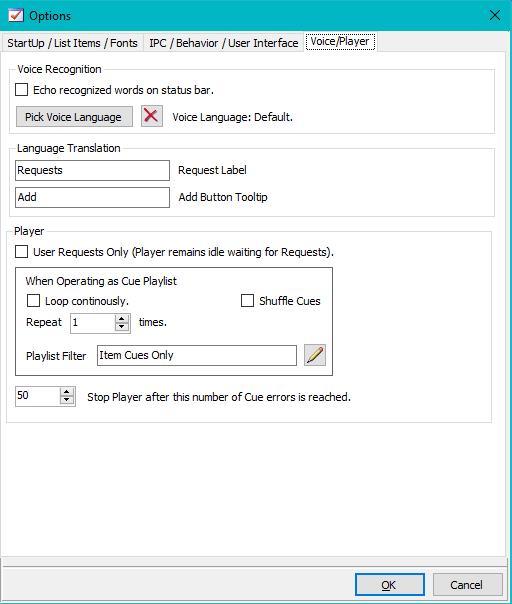
Voice/Player Options
Menu Locator: Tools > Options > Voice tab .
Voice
For more details on these settings, see the Voice page.
- Echo recognized words on status bar - When checked, any recognized spoken words will be echoed to the program status bar. Useful as a debug aid if voice is not working as expected.
- Pick Voice Language - Allows you to select the national language used for voice recognition. When not set to a value, the computer's default national language is used. Default Language is different depending on your country of origin. The Clear button will clear this setting back to the Default. If your desired language is not listed when you click the Pick Voice Language button, see the section below for installation instructions.
Installing Another National Language Package
If the speech national language that you want to use is not installed on the computer, you can download and install it.
- Download Microsoft Speech Platform - Runtime Languages (Version 11) . (free downloads) There are multiple files available for this download. Once you click on the "Download" button, you will be prompted to select the file(s) you need. Some language packages have multiple packages based on country language nuances. For example, Spanish offers packages for Spain and Mexico (es-ES and es-MX repectively) with variations in the way the language is spoken. You only need to download the package that most closely matches the version you want.
- Supported languages and codes (50+ language variations). This link lists all supported languages with associated language codes.
UI Language Translation
These allow changing miscellaneous user interface features for local national languages. The Play Controls button tooltips can be changed under Tools > Standard Terms.
- Request Label - The text used for number of Player requests. Or make it blank if you don't want any text (just the number).
- Add Button Tooltip - Tooltip used for the Player Add Requests button (green plus sign button).
Player
-
User Requests Only. (remains idle waiting for Requests).
When checked, the player only plays user Requests (added via the Add Request button). If there are no Requests in the Requests queue, the Player remains idle until a new request is added. (essentially jukebox behavior)
When unchecked, the player performs like a standard music player using the Cuelist as a playlist. When user Requests are added, any requests will take precedence and will be played next. - Loop continously. - The Player continues to play Cues until you manually stop the player.
- Repeat x times. - The Player plays the whole Cuelist the number of times specified. "1" means only play the Cuelist one time.
- Shuffle Cues - When checked, the Player playlist will be shuffled for random selection when the Player is started. After all cues have played, they will be reshuffled for each new pass. When unchecked, the Player playlist will play selections in sequential mode (in the order they are listed in the user interface(UI)).
- Playlist Filter - The Player will play both types of Cues (Item type and Script type). When you start the player, a playlist is built from the Cue List based on the Playlist Filter. So you can filter the playlist to include: "Item Cues Only", "Script Cues Only", or "All Cues".
- Stop Player after this number of Cue errors is reached. - Cue errors can be detected when the RMM Cuelist does not match the source list in the Remote Client. The Player will be force stopped when this number of errors are encountered. The count is reset every time you start the Player. This prevents the player from entering a run away scenario which could eventually crash RMM.
When Operating as Cue Playlist
- - When operating as a standard player, you can set the number of times the player will play through the entire Cuelist.

Figure 1. Voice Options
 Page Bottom
Page Bottom To Page Top
To Page Top